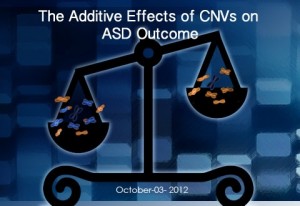Check out other stories from the Latest News
The Additive Effects of CNVs on ASD Outcome
By Eric C. Larsen, Ph.D. on October 3, 2012

Background: The gains or losses of large chunks of DNA, collectively known as copy number variants (CNVs), have in recent years come under increased scrutiny as potential causative factors in human disease. While a number of CNVs at particular locations in the human genome are strongly associated with neurodevelopmental disorders such as Autism Spectrum Disorder (ASD), affected individuals who carry these CNVs display differences both in the type of disease that they have and in the severity of disease, a phenomenon known as phenotypic heterogeneity. Understanding the basis of such phenotypic heterogeneity is critical in being able to correctly interpret the results of genetic screening.
What’s new: In a recent report in the New England Journal of Medicine, researchers screened 2312 children known to carry a CNV associated with neurodevelopmental disorders and congenital anomalies for additional CNVs. The researchers determined that, in addition to the primary CNV, approximately 10% of affected children carried a second large CNV. Not only were affected children more likely to carry multiple CNVs than controls, affected children with more than one CNV tended to display more severe symptoms.
Why it’s important: These findings lend further credence to what the authors of the report refer to as the “two-hit” or second-site model, which suggests that the phenotypic heterogeneity observed in patients with ASD and other neurodevelopmental disorders results from the additive effects of multiple rare genetics variants, such as CNVs.
Help me understand :
| Source(s) : |
| Tweet |

